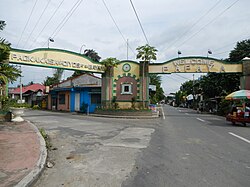General Tinio, Nueva Ecija
| General Tinio | ||
|---|---|---|
| Municipality | ||
 |
||
|
||
| Nickname(s): Papaya | ||
 Map of Nueva Ecija showing the location of General Tinio |
||
| Location within the Philippines | ||
| Coordinates: 15°21′N 121°03′E / 15.350°N 121.050°ECoordinates: 15°21′N 121°03′E / 15.350°N 121.050°E | ||
| Country | Philippines | |
| Region | Central Luzon (Region III) | |
| Province | Nueva Ecija | |
| District | 4th District | |
| Founded | 1921 | |
| Barangays | 13 | |
| Government | ||
| • Mayor | Ferdinand P. Bote | |
| Area | ||
| • Total | 533.08 km2 (205.82 sq mi) | |
| Population (2010) | ||
| • Total | 42,634 | |
| • Density | 80/km2 (210/sq mi) | |
| Time zone | PST (UTC+8) | |
| ZIP code | 3104 | |
| Dialing code | 44 | |
| Income class | 1st class; rural | |
General Tinio is a first class municipality in the province of Nueva Ecija, Philippines. According to the 2010 census, it has a population of 42,634 people. It was known as Papaya until 1957.
The town is at the foot of the Sierra Madre Mountains, adjoining the Fort Magsaysay Army Reservation on the east side. The current town Mayor is Ferdinand P. Bote
General Tinio is politically subdivided into 13 barangays consisting of:
According to the story passed on from one generation to another, the town got its name because of miscommunication between the natives and the Spanish colonizers. A native settler when asked by a Spanish soldier "Llama el pueblo?" replied "Papaya" referring to the particular fruit tree growing abundantly in the place (not understanding the Spanish language). The name stuck to the Spanish colonizers and the place from then on was called "Papaya".
Papaya was a sitio of Bo. Mapisong which was then a barrio of Gapan (now Gapan City). Bo. Mapisong became a town in 1851 changing its name to Peñaranda after a Spanish engineer Jose Maria Peñaranda. Papaya became one of its barangays. Papaya became a town on January 1, 1921, through the collaborative efforts of Capitan Mamerto Padolina who was then the Secretary of the Governor of the Province, Judge Segundo Bernardo and Francisco Padolina.
Congressman Celestino Juan sponsored a congressional act changing the name of Papaya to General Tinio in honor of General Manuel Tinio, a noble and prominent revolutionary leader against the Spaniards who hailed from the Nueva Ecija. The act was signed into law on June 20, 1957 as Republic Act No. 1665. The new name of the town was inaugurated days later, on August 19, 1957.
Recently, the municipal council approved a resolution to rename the town back to its original name, "Papaya".
Beginning the outbreak of World War II, Japanese planes invaded the town of General Tinio during the Japanese Invasion on December 1941. Japanese soldiers entered the municipality on 1942 during the Japanese Occupation. During the occupation, the Japanese soldiers built a military garrison and concentration camp of the Imperial Japanese Armed Forces in the town.
...
Wikipedia


